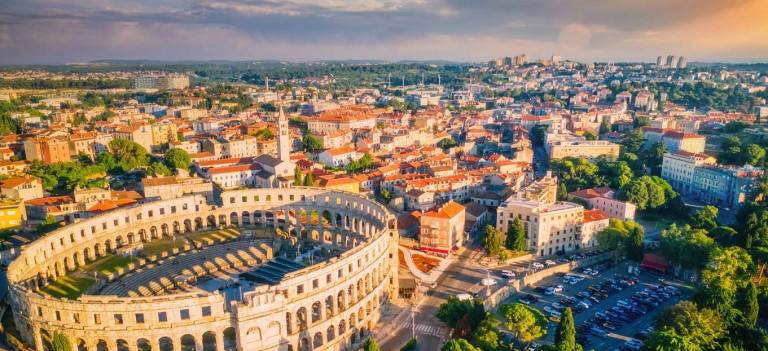
Pula
Colonia Pietas Iulia Pola, as Pula was named by the ancient Romans, has been writing its history for 3000 years. The city built at the end of a beautiful bay and on seven hills reveals many beautiful and interesting stories. According to legend, it was founded by the Colchians, after the pursuit of the Argonauts and their leader Jason, who stole the precious golden fleece from the Colchians.
Today, the city lives in many colors and sounds, perfectly intertwining a colorful and exciting past with the modern times of its residents and visitors. It boasts a perfectly preserved amphitheater, the largest amphora site in the world, the Temple of Augustus, many churches, monasteries, Venetian and Austro-Hungarian architecture, an excellent variety of gastronomic specialties and wine in numerous restaurants, rich museums, galleries, concert events, great nightlife, and many others beauties found in this famous city.

HISTORY
Pula became known as one of the earliest places of human presence. In its vicinity, in a cave called Šandalja, human remains were found (dating back to a million years before Christ). Until the arrival of the Roman legions, Pula was only in the vicinity of Nezakci, settled in the 15th century BC, which became the center of Histra. They are also responsible for the first castle settlement in the area of Pula, on the site of today's Kaštela, built 3,000 years ago, from which the history of the city is calculated.
During the Roman Empire, Pula experienced a real boom. In that period, the water supply system, sewage system, city walls with ten gates, the triumphal arch, temples, theaters, and the famous amphitheater were built. The time of Franks and their empire introduced Pula into feudalism when city-states were created and many conflicts until 1150 when Pula finally swore loyalty to Venice. During this period of conflict and disease, the total population was reduced to only 300 people. Pula was under Venetian rule until 1797 when it became part of the Habsburg Monarchy.
Soon after, in 1805, the French entered the city and took control. Finally, in 1813, Pula returned to the administration of the Austrian Empire, restoring peace and prosperity to the city. In 1859, the impressive port of Pula became the main Austrian port and major shipbuilding center, and Pula had 60,000 inhabitants. After the collapse of Austria-Hungary in 1918, Pula belonged to Italy, under whose rule the Croats were exposed to enormous oppression, forced Italianization, looting, and being sent to camps. Because of this, many fled from Pula and Istria.
Fascist rule lasted until 1943 when the city was taken over by the German army, which continued arrests, deportations, and executions of the local population. Only 3 months after the seizure of power, the allied bombing of the city began, which lasted until March 1945. In that war, many civilians were killed, and numerous historical monuments were destroyed, as well as a part of the old city core. Pula was finally liberated in May 1945 and remained under the regulations of the United Nations until September 1947, when it was officially united with Croatia, and thus with Yugoslavia.
In 1991, after the breakup of Yugoslavia, Pula and Istria became part of the modern Republic of Croatia












